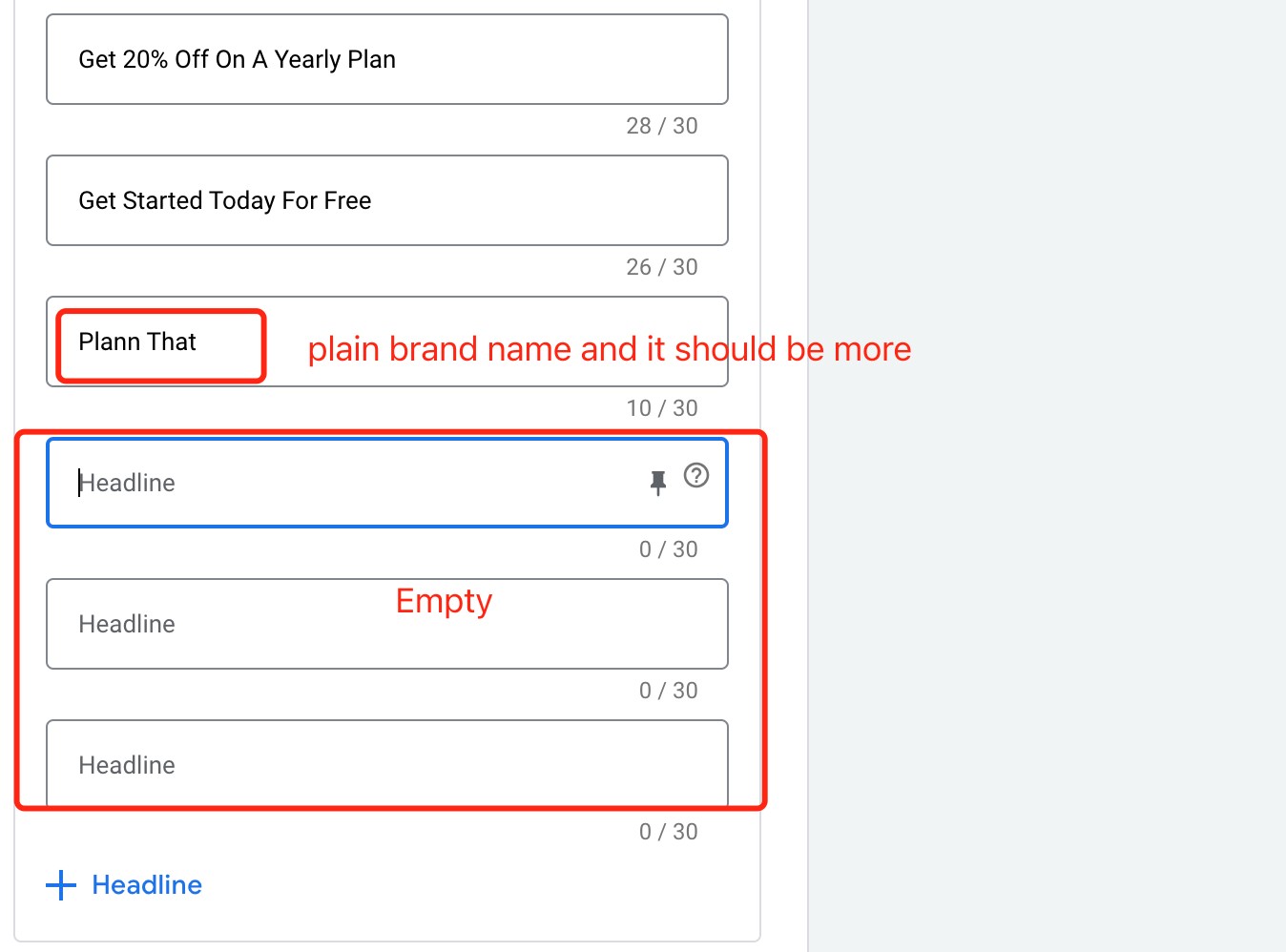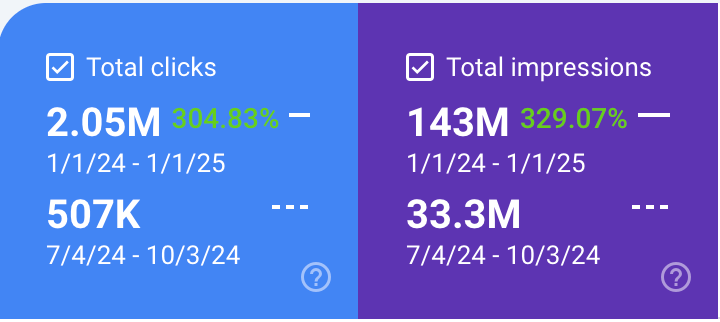Plann Case Study - Transformed Google Ads ROI and SEO Organic Growth
Table of Contents (Click to show/hide)









Plann is a social media scheduler founded by Christy Laurence in 2016. Throughout the years, Plann evolved from a drag-and-drop Instagram scheduler into an all-in-one planner that supports multiple platforms and has multiple robust features.
In 2023, the company increased its marketing budget but didn’t see the expected results. After taking over Plann’s Google Ads account, I identified the main challenges that we would have to deal with. The conversion tracking and keyword strategy needed to be improved as soon as possible to make sure that the campaign better aligned with Plann’s business objectives.
By restructuring the campaign, I managed to over-achieve the target CPA and come up with a strategy that would help the company to continue organically growing throughout the next 2 years.
This case study will show the challenges that I had to face in more detail. I will also explain how I came up with different solutions to each problem and, ultimately, delivered the results that the client was counting on.
Challenge#1 - Chaotic Conversion Settings and Inaccurate Tracking
Plann increased their Google Ads budget, but that did not help them achieve their business goals.
After taking over their account, I found the following issues that needed to be fixed:
- While the increased budget resulted in a 20.55% increase in conversion, the conversions were tracked by Universal Analytic without conversion value which is a huge problem. This disable Account’s ability to use value-bidding smart strategies.
- The UA imported goal is tracked by page load, duplication might occurred due to reload.
- There has been a 14.41% increase in average CPA.
- The enhanced conversion feature, Parallel tracking feature and engaged-view conversion tracking feature weren’t turned on.

- The non-direct last-click attribution model from UA and zero-valued conversion were diluting the accurate tracking. Specifically by using UA tracking only, they were not measuring engaged-view conversion, view-through conversions and cross-device conversions.
-
Pro-tip: Google Ads’ conversion tag measured 20%- 45% more conversion (based on Miles McNair) than Universal Analytics imports because:
- Google Ads conversion tag (or Google Tag) measuring engaged-view conversions
- Google Ads conversion tag (or Google Tag) measuring view-through conversions
- Google Ads conversion tag (or Google Tag) measuring cross-device conversions
- Google Ads conversion tag use data-driven conversion model
The Solution
It was important to take care of the basics first. Conversion tracking often required intermediate technical knowledge which is most of the marketer lack of. A short term-pain is better than shooting in the dark, so I:
- Working with the dev team to set up event triggers on account signup and subscription.
- Set up all website tag as primary conversions and Google Analytics conversions as secondary.
- Link Google Analytics 4, Google Search Console, YouTube Channel. Enable parallel tracking.
- Access control – remove all irrelevant account accesses.
As you can see for now, there are a lot of foundation not set-up properly. It’s a curse but also a blessing. Smart bidding is all about feeding the data reflecting the true business operation. These low-hanging fruits will elevate Plann’s account in no time.
Some other structural changes that I’ve made to the account include:
- Disable the Google Search Partner because we all know it’s trashy traffic
- Restructuring the campaign with proper match type;
- Changing the naming convention of the campaigns (adding keyword themes on ad groups);
- Adding dynamic search Ad as an ad group to generic campaigns as an incremental addition;
- Optimising generic campaigns for mid-funnel conversion goal – “Free Account Sign-up”; And Brand campaign for “subscription”
- Adding a competitor campaign (there was no competitor campaign; however, competitors were bidding on Plann).
- Set up a tracking template with Value Track parameters. Both in campaign & ad group level.
Before I took over the account, exact match keywords were working quite well, but I noticed that the lack of negative keywords put brand and generic search terms mixed up in one ad group. Moreover, the exact match type was limiting the campaign’s potential. I’ve added phrase-match keywords as they can easily become the middle ground between reach and relevance as the company is looking for growth.
Keywords are a great but not the only way to increase reach. Plann is great on content creation, that’s why I have also chosen to use Plann’s blog pages as targets for Dynamic Search Ads. As the pages were already well-optimised, it was easy for DSAs to identify the main themes and terms, leading to an increase in our incremental traffic.
Challenge#2 – Basic Ad Copies
Like many other small businesses account I managed before, Plann wasn’t using total 15 headlines and4 descriptions. Some headlines are just brand name like “Plann That” and that’s it. It not only misses the opportunity to include key phrases in the copy that appeal to the audience, but also lost it chances to showcase brand’s tone of voice and product offerings.

So I focused on crafting an effective ad copy template and created new campaigns for the caption generator and the social media calendar.
My goal here was to make sure the key business messages were delivered to the audience in a way that would make them want to click and interact.
I use the following parameters to identify good creative assets:
- Readability
- Clarity
- Engagement
- Delivery

The copy was not bad overall but missed the Five Principles of Copy Mental Glues(alliteration, double entendre, repetition, reversal, and rhyming). The 15 headlines and ad customiser were not being utilised as well, which makes the optimisation harder to find the best performing copy.
Challenge#3 - Absence of Negative Keywords
Google keeps pushing broad match keywords as it gives the platform more freedom to show the ad for terms that do not match directly with the campaign. While such a strategy can sometimes work, overall, it might quickly turn into a huge waste of advertising budget.
I have noticed that a lot of keywords got matched for search terms like "instagram bot", “gain Instagram followers”, and "ai shorts maker" which are completely irrelevant to Plann's offering.
The Solution
To focus on the keywords that matter to potential customers, I started actively adding negative keywords that were completely neglected before. This is a great way to optimise AI search term matching.
Here’s what I did:
- Created a relevant account-level list of negative keywords;
- Determined broad match, phrase match, and exact match negative keywords;
- Allocated the negative keywords to the right ad group, campaign, and list;
- Optimised all the keywords and grouped them by theme.
You don’t have unlimited negative keyword quota, When coming up with a solution, I adhered to the following negative keyword limits:
- 20 shared negative keyword lists per account;
- 5,000 keywords per negative keyword list;
- 10,000 negative keywords per campaign;
- A maximum of 5,000 negative keywords are considered for Display Network and video campaigns.
Here is my own way to effectively filter search terms and creative air-tight keyword lists:
- Use Negative keyword list applies to campaign-level only, and apply ad group level negative keywords when the search term should be only excluded for a certain ad group.
- Use naming convention for a better organisation and contextual operation: {BAU/Tactical}_Apply to{Brand/Generic/Competitor}_{Topic}_{Creator}_{Created Date}
- When reviewing search terms in the Google Sheet, prepend four additional columns at the front for your final output. (Refer to Table A below for the recommended column structure.)
- For excluding reasons, these typically fall into these categories: (See Table B below for examples of exclusion logic.)
- Start with “Excluding Reason” from point #4, then decide the application level –always start campaign level and use critical thinking to judge if you can accept other ad groups blocking the terms as well. Use that thinking to decide the negative match type. For example, in a brand standard shopping campaign, you can use only negative exact match to exclude all generic search terms that do not contain brand name. If you use broad or phrase match, there will be a chance that the brand name will be appended or prepended to the search term, which is a missing opportunity.
- Finally, you will eventually discover a time-saving trick on negative broad match on singular word or phrase to cover all the bases. (Table C below outlines this approach with examples.)
-


The brand negative keyword list that I have created will help the company spend its budget more effectively and earn better ad placement in the future. And the negative keyword list approach save more negative keyword quota in an account.
Pro-tip: It’s unclear in Google’s official statement but Negative broad match takes the order of the words into account and block search term if there’re words in between.
Refer to the tables below for all examples related to Challenge #3 before proceeding to the next challenge.
Table A
Table B
Table C
Challenge#4 - Underperforming SEO Content
The company was struggling to find the right direction for content creation. Plann’s main aim was to build topical authority, but they didn’t really have an understanding of how to achieve that.
There were also a few issues with the technical aspects:
- The URL structure was interfering with the site’s speed;
- Soft 404s were limiting the website’s crawl coverage by search engines;
- The alt text could have been improved.
The Solution
Content, and how well it’s able to meet the user’s needs, is one of the core factors in Google’s ranking systems. It can become a relatively low-cost marketing channel that would help build brand awareness and increase visibility.
After an SEO consultation, my goal is to help the client improve all the aspects of this extremely important tool.
Here’s what was done for Plann:
- I figured out what the best-performing content was by cross-checking Google Trends and historical organic search performance. To keep the client on the right path, I have also created an easy-to-understand knowledge graph.
- When it comes to new content, I have provided a convenient online page path structure. Some examples include Emoji Meanings Dictionary pages with UX design and CRO and content templates. This page right now ranks #4 on this keyword.
- The internal team was instructed and educated on how to locate the Largest Contentful Paint element. I have then provided a solution to resource compressing to remove the render blocker. The site speed on blog pages has been drastically improved.
- Perhaps my greatest achievement - my knowledge was used to connect ChatGPT Vision API to read all the images without ALT and combine targeted keywords in the prompt to mass generate on-point- contextual ALT. This will allow the client to save plenty of time and energy and create an effective solution allowing Google to crawl and index images. Which improves image search impression by 50% YOY.

The Content Consultation also includes a UX/CRO audit that will help:
- Discover opportunities and weaknesses on the client's web pages;
- Learn more about the user intent and prioritise critical and urgent fixes to enhance the UX;
- Increase overall customer satisfaction.
Challenge #5 – Tactical - Conversion Loss with Enabled Google Login
In late May - early June 2024, I noticed a 50% conversion rate drop from our Google Ads, which led to a 75% increase in our CPA.
The Solution
I’ve tried out a few solutions at the beginning, like negative keywords, adjusting the budget and keyword match type. However, I wasn't able to achieve positive results. It was now obvious that the root cause of the problem was something else sits in the website. Here is my troubleshoot logic:
In August, I managed to spot the issue. It was caused by the newly released "Google Login" feature in the registration process. The new identification service did not set up an event trigger for our “Sign Up” conversion. This means for every user who chose to use their Google Account to sign in Plann’s service, the sign-up event was not registered and sent to Google Ads for conversion tracking.
I immediately patched up the issue, and shortly after that, the campaign saw a +97% sign-up and +4600% on subscriptions. The overflow of success on paid search reaches to a all-time high monthly paid subscription conversions on September and October.
Final Outcomes in My Plann’s Journey
- Primary sign-up CPA: I achieved the primary sign-up target CPA goal of 100% with a further 40% improvement. The end CPA was 40% less than the target sign-up CPA, with a -25.68% YoY improvement.
- Signup Conversion: I achieved +39.98% YoY growth and an average of 13.5% monthly growth.
- Subscription CPA: I achieved a -56.42% YoY improvement, with 20% less than tCPA.
- Subscription Conversion: I achieved 386.67% YoY subscription (paid customer) growth.
- I also spotted a technical conversion tracking barrier in the customer sign-up journey, which recovered around 50% of lost sign-up conversions.
My Experiments
These multiple experiments with tested ad copy and landing page experiences helped me achieve keyword quality score improvements.
All the experiments resulted in actionable findings that helped refine the strategy and take additional steps towards reaching the client’s goals.
The Final Result
- Now, tracking the results of an ad campaign would be a breeze for Plann. To make tracking as accurate as possible, I added the missing touchpoints and restructured the campaign with a proper match style.
- The CPA goal was overachieved thanks to the fact that I added a dynamic search, added a competitor campaign, optimised a generic campaign, and added negative keywords.
- Signup and subscription conversion all reach to the target CPA and will continue to grow thanks to the newly adopted content and SEO strategy - Plann is now ‘speaking’ directly to their target audience.
- Competitors are no longer stealing our potential customers thanks to the impression share bidding strategy that places the ad campaigns at the top of search results.
Most importantly, the development does not stop once my job is done. I provide my clients with the necessary resources, tools, graphs, and tables that they and their teams can use to further improve their workflow. The additional materials also help continue sticking to the plan while always keeping the company’s ultimate goals in mind.
I am happy to say that our collaboration with Plann helped the company update their strategies and campaign structures to align with its business objectives. Can’t wait to see what the future holds for this wonderful team of passionate professionals.
What the Client Has to Say:
Dean is one of the most knowledgeable and impressive marketing leaders I have worked with. Joining Plann on a consultation basis across our SEM + SEO channels, he integrates into the team seamlessly and delivers above and beyond expectations both in terms of quality of knowledge, but also with his commitment to educate and inspire the team.
Dean's technical skills are second to none, he is committed to being at the forefront of industry knowledge and as such, we have immense confidence in his guidance and strategy.
Dean comes with the highest of recommendations. He is a talented, dedicated and inspiring marketing expert, and his witty and personable approach means he's a pure joy to work with.
Toni M, Head of Marketing at Plann

Reference Sources
- https://support.google.com/google-ads/answer/12437241
- https://www.karooya.com/blog/broad-match-negative-keywords-google-ads/




.jpg)




